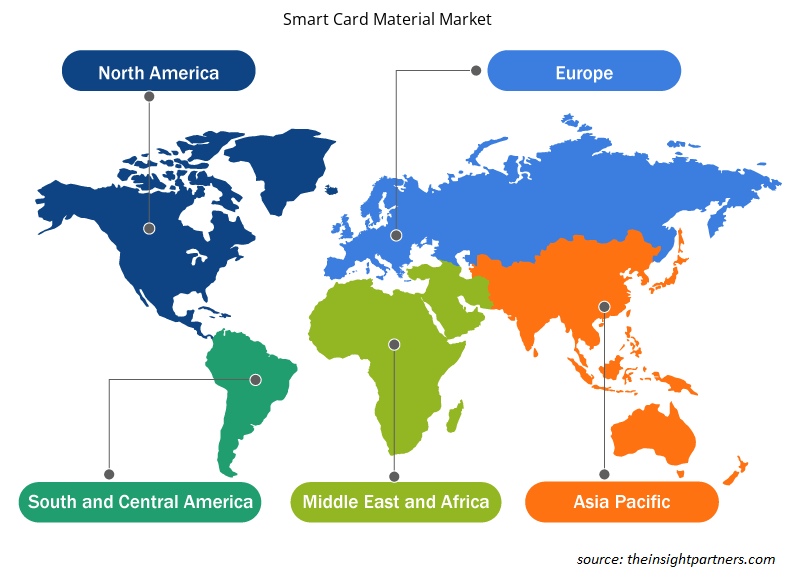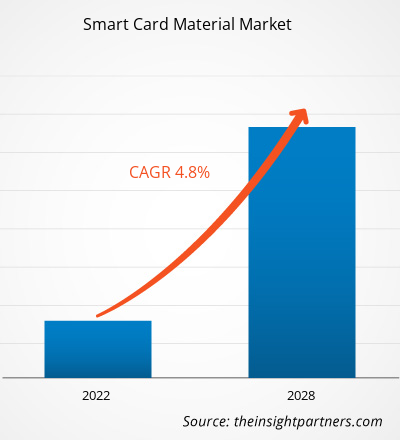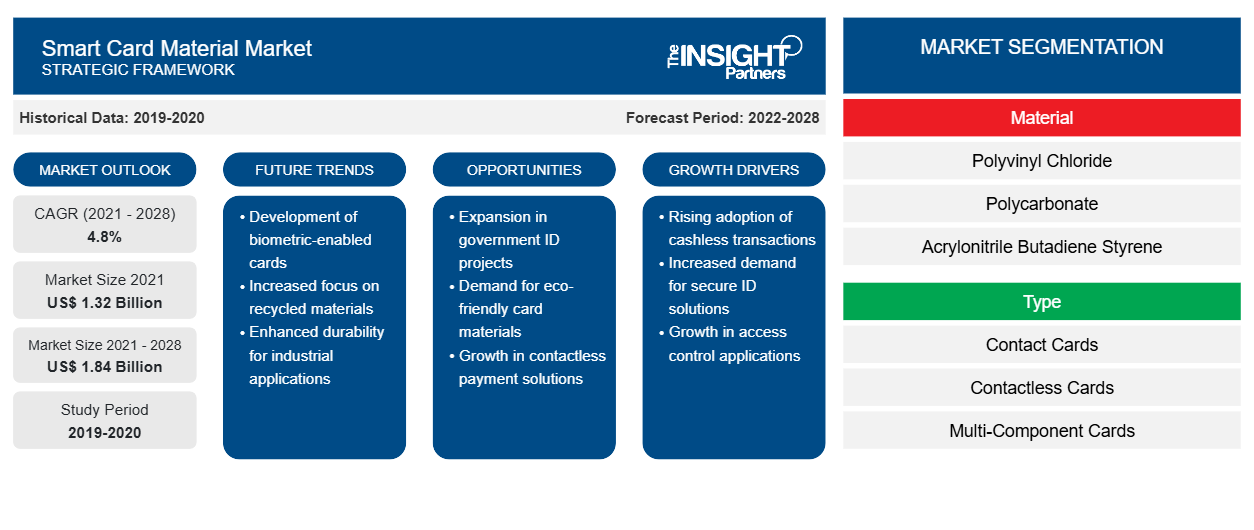من المتوقع أن يصل سوق مواد البطاقات الذكية إلى 1،837.78 مليون دولار أمريكي بحلول عام 2028 من 1324.57 مليون دولار أمريكي في عام 2021؛ ومن المتوقع أن ينمو بمعدل نمو سنوي مركب قدره 4.8٪ من عام 2021 إلى عام 2028.
البطاقة الذكية، وهي نوع من بطاقات الشريحة، هي بطاقة بلاستيكية تحتوي على شريحة كمبيوتر مدمجة إما من نوع الذاكرة أو المعالج الدقيق والتي تخزن البيانات وتتعامل معها. وعادة ما ترتبط هذه البيانات إما بالقيمة أو بالمعلومات، أو بكليهما، والتي يتم تخزينها ومعالجتها داخل الشريحة. تشير مواد البطاقة الذكية إلى المواد الكيميائية المستخدمة في تصنيع هذه البطاقات. تدعم هذه المواد تضمين المعلومات وطباعتها عليها.
في عام 2020، استحوذت منطقة آسيا والمحيط الهادئ على أكبر حصة من سوق مواد البطاقات الذكية العالمية . ويتزايد الطلب على مواد البطاقات الذكية في هذه المنطقة بسبب الاستخدام المتزايد للبطاقات الذكية في قطاع الاتصالات. بالإضافة إلى ذلك، فإن اتجاه العولمة المتزايد؛ وانتشار صناعة الخدمات المصرفية والمالية والتأمين (BFSI) هي عوامل رئيسية تدعم نمو سوق مواد البطاقات الذكية في المنطقة.
قم بتخصيص هذا التقرير ليناسب متطلباتك
ستحصل على تخصيص لأي تقرير - مجانًا - بما في ذلك أجزاء من هذا التقرير، أو تحليل على مستوى الدولة، وحزمة بيانات Excel، بالإضافة إلى الاستفادة من العروض والخصومات الرائعة للشركات الناشئة والجامعات
-
احصل على أهم اتجاهات السوق الرئيسية لهذا التقرير.ستتضمن هذه العينة المجانية تحليلاً للبيانات، بدءًا من اتجاهات السوق وحتى التقديرات والتوقعات.
تأثير جائحة كوفيد-19 على سوق مواد البطاقات الذكية
لقد غير جائحة كوفيد-19 المستمر بشكل كبير وضع قطاع المواد الكيميائية والمواد وأثر على نمو سوق مواد البطاقات الذكية. وقد أثر الانخفاض الكبير في أداء العديد من القطاعات الصناعية على الطلب على مواد البطاقات الذكية. ويختلف تأثير الوباء عبر قطاعات التطبيق المختلفة. وقد استفاد العديد من شركات الاتصالات من زيادة حركة البيانات والخدمات الصوتية، بما في ذلك مشغلو مراكز البيانات ذات النطاق العريض والمتنقلة. ومع ذلك، فإن تدابير الإغلاق التي فرضتها الحكومات أزعجت سلاسل توريد المواد الخام مثل PVS وABS وPETG المطلوبة لتصنيع البطاقات الذكية. وقد أثر انتشار المرض سلبًا على العمليات في قطاعي الحكومة والخدمات المصرفية والمالية والتأمين. ومع ذلك، نظرًا لأن الاقتصادات تخطط لإحياء عملياتها، فمن المتوقع أن يرتفع الطلب على مواد البطاقات الذكية عالميًا في السنوات القادمة.
رؤى السوق
نمو ملحوظ في قطاعي الاتصالات والرعاية الصحية
تُستخدم البطاقات الذكية على نطاق واسع في قطاع الاتصالات. وأبرز استخدام للبطاقات الذكية في هذا القطاع هو في شكل بطاقات وحدة هوية المشترك (SIM) أو بطاقات الدوائر المتكاملة العالمية (UICC). تُصنع هذه البطاقات الذكية في الغالب من مواد البولي فينيل كلوريد (PVC) وأكريلونيتريل بوتادين ستايرين (ABS). وقد خضعت تقنية البطاقات الذكية المستخدمة في التطبيقات في هذا القطاع لتطورات مستمرة في السنوات العديدة الماضية، مما أدى إلى زيادة استهلاك هذه البطاقات. علاوة على ذلك، تنفذ منظمات الرعاية الصحية في جميع أنحاء العالم بطاقات صحية ذكية بمجموعة واسعة من الميزات والتطبيقات.
رؤى إقليمية حول سوق مواد البطاقات الذكية
لقد قام المحللون في Insight Partners بشرح الاتجاهات والعوامل الإقليمية المؤثرة على سوق مواد البطاقات الذكية طوال فترة التوقعات بشكل شامل. يناقش هذا القسم أيضًا قطاعات سوق مواد البطاقات الذكية والجغرافيا في جميع أنحاء أمريكا الشمالية وأوروبا ومنطقة آسيا والمحيط الهادئ والشرق الأوسط وأفريقيا وأمريكا الجنوبية والوسطى.

- احصل على البيانات الإقليمية المحددة لسوق مواد البطاقات الذكية
نطاق تقرير سوق مواد البطاقات الذكية
| سمة التقرير | تفاصيل |
|---|---|
| حجم السوق في عام 2021 | 1.32 مليار دولار أمريكي |
| حجم السوق بحلول عام 2028 | 1.84 مليار دولار أمريكي |
| معدل النمو السنوي المركب العالمي (2021 - 2028) | 4.8% |
| البيانات التاريخية | 2019-2020 |
| فترة التنبؤ | 2022-2028 |
| القطاعات المغطاة |
حسب المادة
|
| المناطق والدول المغطاة |
أمريكا الشمالية
|
| قادة السوق وملفات تعريف الشركات الرئيسية |
|
كثافة اللاعبين في سوق مواد البطاقات الذكية: فهم تأثيرها على ديناميكيات الأعمال
يشهد سوق مواد البطاقات الذكية نموًا سريعًا، مدفوعًا بالطلب المتزايد من المستخدم النهائي بسبب عوامل مثل تفضيلات المستهلك المتطورة والتقدم التكنولوجي والوعي المتزايد بفوائد المنتج. ومع ارتفاع الطلب، تعمل الشركات على توسيع عروضها والابتكار لتلبية احتياجات المستهلكين والاستفادة من الاتجاهات الناشئة، مما يؤدي إلى زيادة نمو السوق.
تشير كثافة اللاعبين في السوق إلى توزيع الشركات أو المؤسسات العاملة في سوق أو صناعة معينة. وهي تشير إلى عدد المنافسين (اللاعبين في السوق) الموجودين في مساحة سوق معينة نسبة إلى حجمها أو قيمتها السوقية الإجمالية.
الشركات الرئيسية العاملة في سوق مواد البطاقة الذكية هي:
- شركة ايستمان للكيماويات
- شركة بتروتشاينا المحدودة
- شركة سولفاي
- كيم واحد
- سابك
إخلاء المسؤولية : الشركات المذكورة أعلاه ليست مرتبة بأي ترتيب معين.

- احصل على نظرة عامة على أهم اللاعبين الرئيسيين في سوق مواد البطاقات الذكية
رؤى التطبيق
بناءً على التطبيق، يتم تقسيم سوق مواد البطاقات الذكية إلى BFSI والحكومة والاتصالات والتجزئة والرعاية الصحية والضيافة وغيرها. احتل قطاع الاتصالات أكبر حصة في سوق مواد البطاقات الذكية في عام 2020. تُستخدم البطاقة الذكية كبطاقات هاتف مدفوعة مسبقًا (بطاقات ذاكرة ذات قيمة مخزنة) وبطاقات SIM أو UICC تعتمد على بطاقة ذكية للمعالج الدقيق في الهواتف المحمولة. أكثر منتجات البطاقات الذكية مبيعًا في هذا القطاع هي SIM وUICC، من حيث الحجم والقيمة.
تشمل بعض الشركات العاملة في سوق مواد البطاقات الذكية العالمية شركة Eastman Chemical Company، وشركة PetroChina Company Limited، وشركة Solvay SA، وشركة KEM ONE، وشركة SABIC، وشركة 3A Composites GmbH، وشركة Teijin Limited، وشركة LG Chem، وشركة BASF SE، وشركة Westlake Chemical Corporation.
تقرير يسلط الضوء على
- اتجاهات الصناعة التقدمية في سوق مواد البطاقات الذكية لمساعدة اللاعبين على تطوير استراتيجيات فعالة طويلة الأجل
- استراتيجيات نمو الأعمال التي تتبناها الشركات العاملة في الأسواق المتقدمة والنامية
- التحليل الكمي لسوق مواد البطاقات الذكية من 2019 إلى 2028
- تقدير الطلب العالمي على مواد البطاقات الذكية
- تحليل القوى الخمس لبورتر لتوضيح فعالية المشترين والموردين العاملين في الصناعة
- التطورات الأخيرة لفهم سيناريو السوق التنافسي
- اتجاهات السوق وتوقعاته بالإضافة إلى العوامل التي تدفع وتكبح نمو سوق مواد البطاقات الذكية
- المساعدة في عملية اتخاذ القرار من خلال تسليط الضوء على استراتيجيات السوق التي تدعم المصلحة التجارية، مما يؤدي إلى نمو سوق مواد البطاقات الذكية
- حجم سوق مواد البطاقات الذكية في العقد المختلفة
- نظرة عامة مفصلة وتقسيم السوق، بالإضافة إلى ديناميكيات صناعة مواد البطاقات الذكية
- حجم سوق مواد البطاقات الذكية في مختلف المناطق مع فرص نمو واعدة
سوق مواد البطاقات الذكية
حسب المادة
- بولي فينيل كلوريد (PVC)
- البولي كربونات (PC)
- أكريلونيتريل بوتادين ستايرين (ABS)
- بولي إيثيلين تيريفثالات جليكول (PETG)
- آحرون
حسب النوع
- بطاقات الاتصال
- البطاقات اللاتلامسية
- بطاقات متعددة المكونات
حسب الطلب
- الخدمات المالية والمصرفية والتأمين
- حكومة
- اتصالات
- بيع بالتجزئة
- الرعاية الصحية
- ضيافة
- آحرون
نبذة عن الشركة
- شركة ايستمان للكيماويات
- شركة بتروتشاينا المحدودة
- شركة سولفاي
- كيم واحد
- سابك
- شركة 3A للمركبات المحدودة
- شركة تيجين المحدودة
- إل جي كيم
- باسف اس اي
- شركة ويستليك للكيماويات
- التحليل التاريخي (سنتان)، سنة الأساس، التوقعات (7 سنوات) مع معدل النمو السنوي المركب
- تحليل PEST و SWOT
- حجم السوق والقيمة / الحجم - عالمي، إقليمي، بلد
- الصناعة والمنافسة
- مجموعة بيانات إكسل
التقارير الحديثة
شهادات العملاء
سبب الشراء
- اتخاذ قرارات مدروسة
- فهم ديناميكيات السوق
- تحليل المنافسة
- رؤى العملاء
- توقعات السوق
- تخفيف المخاطر
- التخطيط الاستراتيجي
- مبررات الاستثمار
- تحديد الأسواق الناشئة
- تحسين استراتيجيات التسويق
- تعزيز الكفاءة التشغيلية
- مواكبة التوجهات التنظيمية























 احصل على عينة مجانية ل - سوق مواد البطاقات الذكية
احصل على عينة مجانية ل - سوق مواد البطاقات الذكية